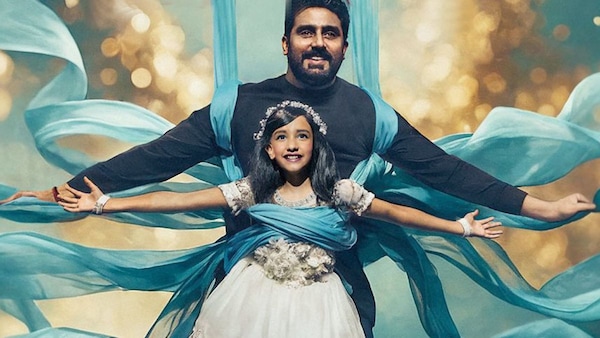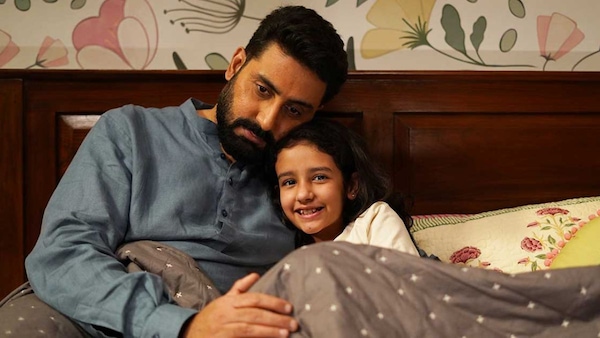Be Happy Is A Sappy Episode Of Reality Television
Be Happy claims to spotlight dance but does so dishonestly, ultimately playing like a promotional reel for several reality shows Remo D'Souza judges while reducing its serious themes to a footnote.

Promo poster for Be Happy.
Last Updated: 08.26 PM, Mar 14, 2025
ABHISHEK BACHCHAN is in his father-era. He has played the doting father in the last couple of his films (Ludo, Bob Biswas, I Want to Talk). With his latest work Remo D'Souza’s Be Happy, he perpetuates the tradition but lands as the most inefficient father in a worryingly inefficient film that cares little about human beings and reserves all its sympathy, empathy and emotions for dance. The level of commitment to the form outgrows everything and everyone else, even when that includes a cancer-afflicted child.
It is not wholly surprising. Remo D'Souza, who started out as a choreographer, has built his career as a director on the back of films on dance ( F.A.L.T.U, ABCD: Any Body Can Dance, ABCD 2). This is an acceptable proposition but they were either mainly about dance or could accommodate the practice with ease. Be Happy (written by Tushar Hiranandani, Kanishka Deo Chirag Garg and D'Souza) plays out like two different films – one about dance and another about a widowed man learning to live again with his daughter. The filmmaker tries melding them with dance to possibly underline its transformative power but ends up crafting Be Happy (a puzzling title) as a long, sappy episode of reality television. Except in this case, the camera followed the contestant at her home.

If Be Happy is to be believed that dance is healing, dancers are healers and nothing and nobody can stop that from happening. These are great inferences but D'Souza treats them with literalness that affords no space for subtext. He extends that to everything else. A funny scene is scored to a background score that spells out it is funny, an awkward encounter is accompanied by background music that says, “run run” and more crucially, and this is the clincher, we know that it is a film about dreams not because it is repeated 12 times but because we hear the words, “dream, dream, dreammmmm” more often than we don’t.
Dhara Rastogi (Inayat Verma) dreams of being a dancer (dream, dream, dreammmmm). The film opens with her dreaming about it (dream, dream, dreammmmm – okay I will stop) and as she takes a turn, she tumbles out of bed. Dhra opens her eyes and sees her father, Shiv (Bachchan) looking at her fall without picking her up. In case it wasn’t clear, this implies (and the characters soon chime in) that she wants to be a dancer and he does not approve of it. She wants to join a reality show in Mumbai and live in Ooty, but he refuses to shift. It is only Dhara’s grandfather (the wonderful Nassar) who offers support.
The rest of Be Happy unfolds as a tug-of-war between Dhara and Shiv till the latter relents. D'Souza imbues this simple plot with insulting simplicity. She emotionally blackmails him, and he resists. She coaxes again, throwing the convenient “mom would have done it” line and he agrees. And when they go to Mumbai she shines bright till her dreams come crashing down. In the midst, the role of dance keeps expanding till it occupies the centre stage. It is a bizarre segue because it fans misconceptions.

Be Happy proposes that reality show sets are the safest of safe spaces, the judges are the most empathetic beings (Nora Fatehi plays Dhara’s teacher in Mumbai and she is almost maternal in her affections) and kids have no mean bone in their body (all the children in the dance school dote on Dhara). These ideas and execution fall in line with the central crux of the film, suggesting that to dance one needs to be happy. In one scene, Shiv, broken with the grief of losing his wife many years ago, is told to imagine her and be happy. He closes his eyes and in a whiff, all accrued sadness evaporates and he starts dancing.
Later, when Shiv is on his way to the hospital he breaks into a wild dance on the road for Ganesh Chaturthi. The sequence makes no sense because the poor girl is waiting and also because who does that? Be Happy keeps finding excuses to bring dance to focus and the attempt is so dishonest that the film culminates as a promotional exercise of the several reality shows that D'Souza serves as a judge on, reducing the more serious themes (cancer is treated as an aesthetic) to a footnote. The oversight gets reflected in other things. For instance, there is a scene where Nassar video calls Dhara, and Ooty is wrapped in darkness while there is bright sunshine in Mumbai. In all the fuss about dancing, the filmmaker forgets basic details.

This artifice aligns with the performances. Bachchan seems insincere, detached and non-committal in a role he has done multiple iterations of. As Shiv, he looks like a middle-class bank employee but falls back on familiar tropes in his portrayal of a single father. With Dhara, Verma joins the long line of precocious children looking for future spouses for their single dads (Anjali from Kuch Kuch Hota Hai started the trend). Nassar and Fatehi are impressive in their turns despite having little to work with.
A film titled Be Happy gives little reasons to be happy about. But then for D'Souza one needs to dance to be happy and one can dance if they are happy. Skill sets are incidental, practice is avoidable. Reality shows are fundamental and parental support is inevitable. All that one needs to do is dream, dream, dreammmmm.
Be Happy is currently streaming on Prime Video.

 Premium
Premium